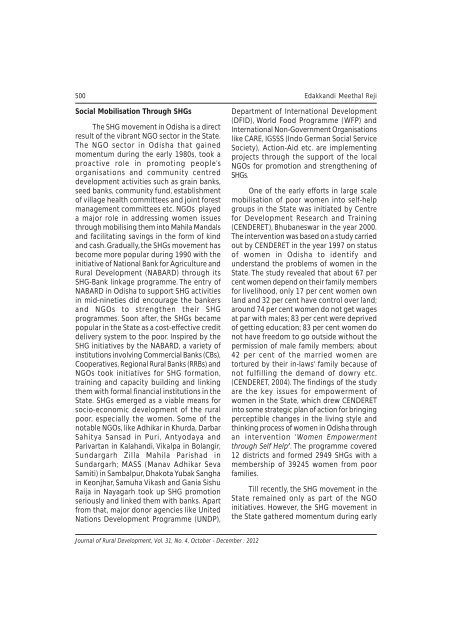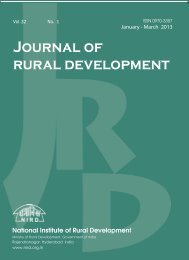October - December 2012 - National Institute of Rural Development
October - December 2012 - National Institute of Rural Development
October - December 2012 - National Institute of Rural Development
- No tags were found...
You also want an ePaper? Increase the reach of your titles
YUMPU automatically turns print PDFs into web optimized ePapers that Google loves.
500 Edakkandi Meethal RejiSocial Mobilisation Through SHGsThe SHG movement in Odisha is a directresult <strong>of</strong> the vibrant NGO sector in the State.The NGO sector in Odisha that gainedmomentum during the early 1980s, took aproactive role in promoting people’sorganisations and community centreddevelopment activities such as grain banks,seed banks, community fund, establishment<strong>of</strong> village health committees and joint forestmanagement committees etc. NGOs playeda major role in addressing women issuesthrough mobilising them into Mahila Mandalsand facilitating savings in the form <strong>of</strong> kindand cash. Gradually, the SHGs movement hasbecome more popular during 1990 with theinitiative <strong>of</strong> <strong>National</strong> Bank for Agriculture and<strong>Rural</strong> <strong>Development</strong> (NABARD) through itsSHG-Bank linkage programme. The entry <strong>of</strong>NABARD in Odisha to support SHG activitiesin mid-nineties did encourage the bankersand NGOs to strengthen their SHGprogrammes. Soon after, the SHGs becamepopular in the State as a cost-effective creditdelivery system to the poor. Inspired by theSHG initiatives by the NABARD, a variety <strong>of</strong>institutions involving Commercial Banks (CBs),Cooperatives, Regional <strong>Rural</strong> Banks (RRBs) andNGOs took initiatives for SHG formation,training and capacity building and linkingthem with formal financial institutions in theState. SHGs emerged as a viable means forsocio-economic development <strong>of</strong> the ruralpoor, especially the women. Some <strong>of</strong> thenotable NGOs, like Adhikar in Khurda, DarbarSahitya Sansad in Puri, Antyodaya andParivartan in Kalahandi, Vikalpa in Bolangir,Sundargarh Zilla Mahila Parishad inSundargarh; MASS (Manav Adhikar SevaSamiti) in Sambalpur, Dhakota Yubak Sanghain Keonjhar, Samuha Vikash and Gania SishuRaija in Nayagarh took up SHG promotionseriously and linked them with banks. Apartfrom that, major donor agencies like UnitedNations <strong>Development</strong> Programme (UNDP),Department <strong>of</strong> International <strong>Development</strong>(DFID), World Food Programme (WFP) andInternational Non-Government Organisationslike CARE, IGSSS (Indo German Social ServiceSociety), Action-Aid etc. are implementingprojects through the support <strong>of</strong> the localNGOs for promotion and strengthening <strong>of</strong>SHGs.One <strong>of</strong> the early efforts in large scalemobilisation <strong>of</strong> poor women into self-helpgroups in the State was initiated by Centrefor <strong>Development</strong> Research and Training(CENDERET), Bhubaneswar in the year 2000.The intervention was based on a study carriedout by CENDERET in the year 1997 on status<strong>of</strong> women in Odisha to identify andunderstand the problems <strong>of</strong> women in theState. The study revealed that about 67 percent women depend on their family membersfor livelihood, only 17 per cent women ownland and 32 per cent have control over land;around 74 per cent women do not get wagesat par with males; 83 per cent were deprived<strong>of</strong> getting education; 83 per cent women donot have freedom to go outside without thepermission <strong>of</strong> male family members; about42 per cent <strong>of</strong> the married women aretortured by their in-laws' family because <strong>of</strong>not fulfilling the demand <strong>of</strong> dowry etc.(CENDERET, 2004). The findings <strong>of</strong> the studyare the key issues for empowerment <strong>of</strong>women in the State, which drew CENDERETinto some strategic plan <strong>of</strong> action for bringingperceptible changes in the living style andthinking process <strong>of</strong> women in Odisha throughan intervention ‘Women Empowermentthrough Self Help’. The programme covered12 districts and formed 2949 SHGs with amembership <strong>of</strong> 39245 women from poorfamilies.Till recently, the SHG movement in theState remained only as part <strong>of</strong> the NGOinitiatives. However, the SHG movement inthe State gathered momentum during earlyJournal <strong>of</strong> <strong>Rural</strong> <strong>Development</strong>, Vol. 31, No. 4, <strong>October</strong> - <strong>December</strong> : <strong>2012</strong>

















